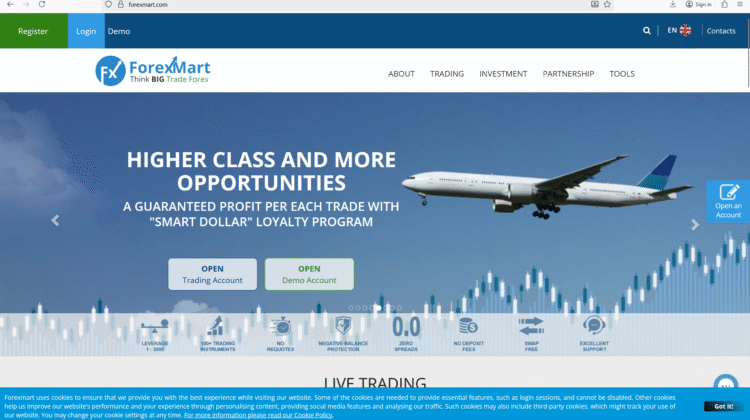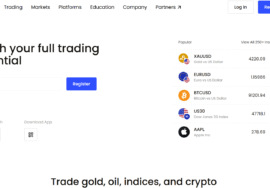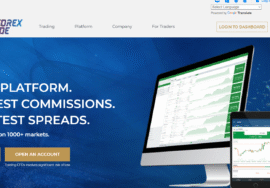
7 Merciless Exposures of ForexMart What Every Trader Must Know
7 Merciless Exposures of ForexMart What Every Trader Must Know
1. Regulation: Illusion, Not Assurance
ForexMart paints itself as a regulated broker with European legitimacy — claiming operations via a Cyprus-licensed entity (Tradomart Ltd) under CySEC and cross-border permissions. Some public sources assert CySEC license 266/15 under its name. But scrutiny by independent broker evaluators warns that ForexMart is not regulated by a “top-tier” authority and lacks consistent enforcement transparency. BrokerChooser, for example, states that ForexMart “is not regulated by a top-tier regulator,” and thus using it means exposing money to weaker oversight and higher risk. The broker markets regulated status in certain jurisdictions, but in practice much of their business appears to operate under lower-scrutiny regimes. The result? A regulatory foundation that feels strong from a distance but weak when challenged.
2. Account Options That Hide Tradeoffs
ForexMart offers multiple account types: Classic, Pro, Cent, Zero Spread. The Classic account includes the broker’s margin in its floating spread; the Zero Spread account advertises zero pip spreads but imposes commissions and tight conditions. According to user and review sources, spreads on Standard or Classic accounts typically start around 0.8 to 1.2 pips on major currency pairs. For the Zero Spread version, there’s a commission (often around $3 per lot) to offset the “zero spread” promise. In low-volatility or low-liquidity times, spread widening or slippage frequently erodes the cost advantage. Traders who choose what seems like the “lowest fee” option often discover hidden drawbacks when execution conditions shift.
3. Fees & Hidden Costs That Erode Your Edge
ForexMart claims no deposit fee and no account maintenance or inactivity fees. But withdrawal fees do apply — typically between 1 % and 3 %, depending on the payment method. Spread and commission costs are also variable, and during volatile market conditions spreads can jump significantly. Review analyses give their fee structure a “medium” rating, implying it’s neither extremely unfair nor fully transparent. Extra hidden costs arise via currency conversion, variable overnight swaps, and slippage in fast markets. Over time, those small “invisible drains” add up, especially for frequent or leveraged traders.
4. Deposit Ease vs Withdrawal Friction
One of the sharpest red flags in many trader complaints is that depositing funds is fast and seamless, but withdrawing them is difficult and delayed. Many ForexMart users report additional identity verification requests when requesting withdrawals, partial rejections, or forced bonus cancellations. Some testify that withdrawal requests are processed slowly or get stuck under “compliance review” after making profits. While the broker advertises near-24-hour withdrawal processing for some methods, real experiences suggest that high withdrawals or profit amounts draw intensive scrutiny. That asymmetry — smooth inflow, difficult outflow — is a warning sign of an operations model designed to favor capital retention.
5. Execution, Slippage & Platform Behavior Under Stress
ForexMart leverages the MT4 (MetaTrader 4) platform, a well-known, robust system trusted by many traders. But execution reliability depends not just on the front end but the broker’s internal order routing and liquidity matching. Traders across forums report issues: orders executed at worse prices than quoted, delayed fills during volatile news events, and in extreme cases trades being rejected or re-quoted unfavorably. Because ForexMart likely med-dispatches routing through liquidity providers under its control, those execution variances may disproportionately impact positions that are moving in profit. A broker can claim “market execution,” but if its back end consistently favors the house, the trader pays.
6. Marketing, Awards & Trust Signals That May Be Manufactured
ForexMart promotes itself with awards (“Best New Broker,” “Best Trading Conditions in Asia”), sponsorships, and promotional visibility. Those marketing badges help it appear credible in retail channels. But many of these awards come from industry awards programs or publications that may offer recognition for payment or promotional partnership rather than unbiased evaluation. Meanwhile, independent feedback reviews (like Trustpilot or forum complaints) often show serious issues. That discrepancy suggests the broker’s external reputation is bolstered by curated signals rather than fully earned trust. A credible broker would allow critique and not rely heavily on polished upside imagery.
7. Repeated Complaints Reveal a Pattern, Not Isolated Cases
When dozens or hundreds of traders across regions report similar problems — withdrawal delays, cancelled bonus conditions, hidden costs, execution irregularities — that’s not coincidence. It’s pattern. User feedback from broker discussion boards and review websites frequently mentions clients being blocked from withdrawing profits, having to pass endless compliance hoops, or losing part of their gains due to change in terms. Some say that promotional trades are allowed, but when they try to pull profits, the barriers appear. The consistency of these stories across independent sources paints a systemic operational risk with ForexMart, not a rare misstep.
Conclusion — The Hard Judgment on ForexMart
ForexMart presents an appealing facade: multiple account types, low entry thresholds, competitive spreads, and a brand that suggests legitimacy and reach. But under that veneer lie serious structural inconsistencies, opaque cost levers, and user-reported patterns of friction that cast doubt on its trustworthiness.
Regulation is the first critical test. On paper, ForexMart points to a CySEC registration to anchor its legitimacy. In reality, that regulatory layer seems thin, inconsistently applied, and often overshadowed by operations in less regulated environments. When independent watchdogs warn that it is not regulated by top-tier regulators, that deserves full attention. A broker must not only claim regulation, it must live it — transparency, accountability, auditability — not selective compliance.
Its account structures promise flexibility, but the cost tradeoffs are subtle and shifting. A “zero spread” account isn’t automatically better when commissions, slippage, and execution gaps erode your margin. The “standard spread” account is burdened by widening spreads during stressful market conditions. Traders must remain constantly alert to how their costs shift with market dynamics.
Fees float under the surface like underwater mines. Withdrawal fees, variable swaps, conversion costs, hidden slippages — each alone might not break you, but collectively they bleed a trading account dry. In the real world of high-frequency or leveraged strategies, those costs become deterministic disadvantages. The broker that hides fees in vague terms hides its leverage.
The deposit/withdrawal asymmetry is one of the most telling features. If your money goes in with little friction but emerges only after hurdles, you are not dealing with a partner — you are dealing with a gatekeeper. The stories from users describe identity verifications springing up only when profits are being withdrawn, bonus cancellations or contract changes, and indefinite delays under “compliance.” That’s a structural risk, not occasional glitch.
Execution reliability is another critical battleground. MT4 is solid, but only when the broker’s backend doesn’t shift midstream to benefit itself. Slippage or order rejections disproportionately during favorable trades suggest the broker is leveraging asymmetry in its favor. A platform must be fair under all conditions, not just when your trades lose.
Marketing and reputation signals are vulnerable to manipulation. Awards and sponsorships can be purchased or influenced; what matters is what users experience when reality meets claim. Frequent discrepancies between glowing official marketing and bitter user reviews indicate a disjoint between image and integrity. A trustworthy broker would stand even when critics emerge.
Finally, patterns of complaint across time and geography reveal a systemic operational strategy. When traders worldwide, independently, relate similar grievances—withdrawals blocked, execution issues, surprise fees—it’s not rare. It’s consistent. That repeatability suggests that the risky behavior is built into the model.
If you plan to trade with ForexMart, treat your capital as a test. Start with minimal amounts. Make small withdrawals early. Record everything interactions, take screenshots. Demand proof of fund segregation, audit reports, and clear, static fee disclosures. If at any point the broker hesitates or refuses, treat that as refusal to earn your trust.
In the end, what matters in a broker is not the number of features, but the guarantee that your path in and path out are fair, transparent, and consistent. On that test, ForexMart repeatedly shows faults and frictions. It is not the worst broker in the market, but it belongs on the “approach with caution” list for any serious trader.
Your capital isn’t free capital it’s your right. A broker’s job is to execute your strategy, not manipulate your exit. ForexMart’s design, from regulatory gaps through hidden fees and withdrawal friction, suggests it often acts against that principle. Proceed only if you plan for every downside and never assume goodwill.







